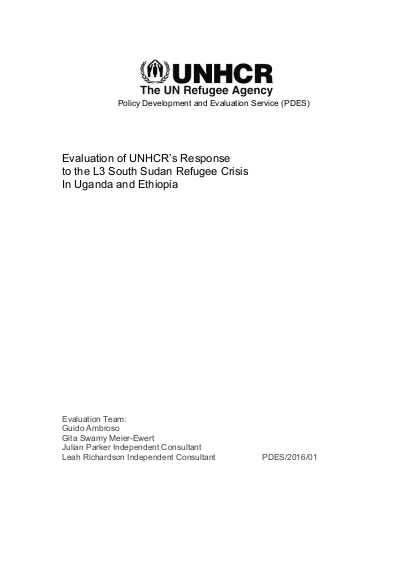
The Evaluation of UNHCR’s response to the refugee emergency in Ethiopia and Uganda follows from the declaration of the L3 emergency for South Sudan on 3 February 2014.1 20. It was undertaken in line with UNHCR’s revised Policy on emergency Response, Activation, Leadership and Activities approved by the High Commissioner on 21st January 2015.
On 15 December 2013, clashes broke out in Juba between competing factions within the ruling Sudan People’s Liberation Movement/Army (SPLM/A) which constituted the backbone of the Government, and the situation quickly degenerated into a full-scaled conflict along ethnic lines. By the beginning of 2015 there were approximately 1.5 million IDPs registered in South Sudan and over 500,000 South Sudanese refugees in the neighbouring countries in addition to the 130,000 who had fled before the December 2013 violence, for a total of over 30 630,000 refugees. This influx stretched the local absorption capacities considering that these countries were already hosting hundreds of thousands of refugees such as Somalis in Ethiopia and Kenya, Congolese in Uganda and Eritreans in Sudan. The vast majority of refugees were women and children. The speed and magnitude of the influx appears to have taken everyone by surprise. The Evaluation of UNHCR’s response to the refugee emergency in Ethiopia and Uganda follows from the declaration of the L3 emergency for South Sudan on 3 February 2014.1 20. It was undertaken in line with UNHCR’s revised Policy on emergency Response, Activation, Leadership and Activities approved by the High Commissioner on 21st January 2015. On 15 December 2013, clashes broke out in Juba between competing factions within the ruling Sudan People’s Liberation Movement/Army (SPLM/A) which constituted the backbone of the Government, and the situation quickly degenerated into a full-scaled conflict along ethnic lines. By the beginning of 2015 there were approximately 1.5 million IDPs registered in South Sudan and over 500,000 South Sudanese refugees in the neighbouring countries in addition to the 130,000 who had fled before the December 2013 violence, for a total of over 30 630,000 refugees. This influx stretched the local absorption capacities considering that these countries were already hosting hundreds of thousands of refugees such as Somalis in Ethiopia and Kenya, Congolese in Uganda and Eritreans in Sudan. The vast majority of refugees were women and children. The speed and magnitude of the influx appears to have taken everyone by surprise. The Evaluation of UNHCR’s response to the refugee emergency in Ethiopia and Uganda follows from the declaration of the L3 emergency for South Sudan on 3 February 2014.1 20 It was undertaken in line with UNHCR’s revised Policy on Emergency Response, Activation, Leadership and Activities approved by the High Commissioner on 21st January 2015. On 15 December 2013, clashes broke out in Juba between competing factions within the ruling Sudan People’s Liberation Movement/Army (SPLM/A) which constituted the backbone of the Government, and the situation quickly degenerated into a full-scaled conflict along ethnic lines. By the beginning of 2015 there were approximately 1.5 million IDPs registered in South Sudan and over 500,000 South Sudanese refugees in the neighbouring countries in addition to the 130,000 who had fled before the December 2013 violence, for a total of over 30 630,000 refugees. This influx stretched the local absorption capacities considering that these countries were already hosting hundreds of thousands of refugees such as Somalis in Ethiopia and Kenya, Congolese in Uganda and Eritreans in Sudan. The vast majority of refugees were women and children. The speed and magnitude of the influx appears to have taken everyone by surprise.
